| Image | Name | Common name | Distribution | Elevation (m) |
|---|
| Sarcochilus argochilus D.L.Jones & M.A.Clem., 2006 | northern lawyer orchid | Queensland | 400–1,000 metres (1,300–3,300 ft) |
| Sarcochilus australis (Lindl.) Rchb.f. in Walp., 1863 | butterfly orchid, Gunn's tree orchid | New South Wales through south-eastern Victoria to northern Tasmania. | 0–1,000 metres (0–3,281 ft) |
| Sarcochilus borealis (Nicholls) D.L.Jones & M.A.Clem., 1989 | small lawyer orchid | New South Wales and Queensland | 800–1,000 metres (2,600–3,300 ft) |
 | Sarcochilus ceciliae F.Muell., 1865 | fairy bells | Queensland and New South Wales | 150–900 metres (490–2,950 ft) |
| Sarcochilus chrysanthus Schltr., 1913 | | New Guinea | 1,000–2,400 metres (3,300–7,900 ft) |
| Sarcochilus dilatatus F.Muell., 1859 | brown butterfly orchid | Queensland and New South Wales | 0–400 metres (0–1,312 ft) |
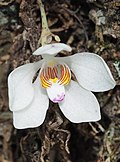 | Sarcochilus falcatus R.Br., 1810 | orange blossom orchid | Queensland, New South Wales and Victoria | 100–1,400 metres (330–4,590 ft) |
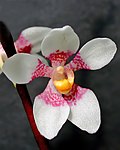 | Sarcochilus fitzgeraldii F.Muell., 1870 | ravine orchid | Queensland and New South Wales | 500–800 metres (1,600–2,600 ft) |
| Sarcochilus gildasii N.Hallé, 1986 | | New Caledonia | |
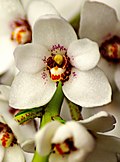 | Sarcochilus hartmannii F.Muell., 1874 | large boulder orchid | eastern Australia | 0–1,000 metres (0–3,281 ft) |
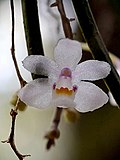 | Sarcochilus hillii (F.Muell.) F.Muell, 1860 | myrtle bells | Australia and New Caledonia | 0–800 metres (0–2,625 ft) |
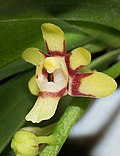 | Sarcochilus hirticalcar (Dockrill) M.A.Clem. & B.J.Wallace, 1998 | harlequin orchid | Queensland | 300–650 metres (980–2,130 ft) |
| Sarcochilus iboensis Schltr., 1913 | | New Guinea | 1,000 metres (3,300 ft) |
| Sarcochilus koghiensis Schltr., 1911 | | New Caledonia | |
| Sarcochilus odoratus Schltr., 1913 | | New Guinea | 200 metres (660 ft) |
 | Sarcochilus parviflorus Lindl., 1838 | southern lawyer orchid, green tree orchid | New South Wales | 600 metres (2,000 ft) |
| Sarcochilus rarus Schltr., 1906 | | New Caledonia | |
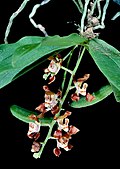 | Sarcochilus serrulatus D.L.Jones, 1972 | banded butterfly orchid | Queensland | 900–600 metres (3,000–2,000 ft) |
| Sarcochilus spathulatus R.S.Rogers, 1927 | small butterfly orchid | Queensland and New South Wales | 0–600 metres (0–1,969 ft) |
| Sarcochilus thycola (N.Hallé) M.A.Clem., D.L.Jones & D.P.Banks, 2019 | | New Caledonia | |
| Sarcochilus tricalliatus (Rupp) Rupp, 1951 | | Queensland | 200–800 metres (660–2,620 ft) |
| Sarcochilus uniflorus Schltr., 1913 | | New Guinea | 1,000–2,200 metres (3,300–7,200 ft) |
| Sarcochilus weinthalii F.M.Bailey, 1903 | blotched butterfly orchid | Queensland and New South Wales | 300–700 metres (980–2,300 ft) |
|








